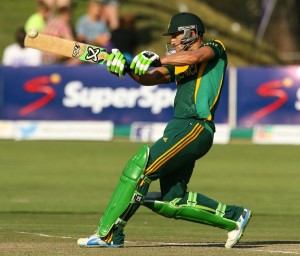By: Firdose Moonda (ESPNcricinfo)
South Africa needed 91 runs from 77 balls when AB de Villiers, with 91 to his name and cramp slicing through his hamstring, walked across his crease, got down on one knee and scooped James Faulkner over his left-shoulder onto the open stands for six. In that one shot, all the questions about South Africa’s ability to take on the best were answered.
De Villiers saw his childhood friend Faf du Plessis record his first ODI century in his 51st game, scored a hundred of his own and was there to scamper the winning single when JP Duminy called for it with 21 balls remaining.
The seven-wicket win in a 300-plus chase was as comprehensive as South Africa could have wanted after Australia controlled most of first half. Aaron Finch’s fourth ODI century saw them through the middle-over squeeze and set up for a strong finish. Australia took 93 runs off the last 10 overs to post 327 but South Africa did not need a similarly swift response. De Villiers and du Plessis shared a record 206-run third-wicket stand, the highest at Harare Sports Club and the highest for South Africa against Australia, to break the back of the chase and put bowling issues on the backburner for now.
Both teams would be disappointed with their performance in the field, Australia more than South Africa, because they put down two chances as well as bled runs. Mitchell Johnson let de Villiers off the hook in his follow through when he was on 78 and George Bailey put him down at point on 85. Add that to the knowledge that none of their bowlers held an end and Australia will have some scrutinising to do.
Johnson was over-reliant on his short ball, which lacked its usual venom on a surface without much in it. Mitchell Starc, Kane Richardson and James Faulkner also struggled to find the right length and the absence of a specialist spinner, with Nathan Lyon benched, was shown up especially against Imran Tahir’s returns.
Tahir was South Africa’s best performer with the ball and put the brakes on Australia after Finch and Phillip Hughes gave them a start of 62 runs in the first 10 overs. He removed both Hughes and Mitchell Marsh in his first spell which formed part of a ten-over period in which South Africa gave away just 32 runs and one boundary.
That proved vital because they lacked control later on as Finch and Bailey combined to threaten a late burst. Finch went from 80 to a century in 11 balls while Bailey tore into Morne Morkel and Ryan McLaren short balls to leave de Villiers without a banker for the death. Wayne Parnell, who conceded 46 runs in six overs thanks largely to a misdirected line down the leg-side, was used in the final over and cost de Villiers 20 runs. But all that was made to seem minimal when South Africa were at the crease.
Quinton de Kock and Hashim Ama were merciless on width in the opening passages and wiped away 44 runs in seven overs before Australia grabbed the upper-hand. Amla was well caught by Steven Smith at point and de Kock top-edged a pull to deep square leg to leave South Africa stuttering.
But de Villiers and du Plessis played partly with the watchfulness they employed in the Adelaide Test match almost three years ago and partly with aggression to keep South Africa in the hunt. They ran well between the wickets even when de Villiers was in so much discomfort he needed on-field treatment, they punished anything on a length and did not take risks until de Villiers offered his twin chances.
The two drops may have been the turning point because as Australia’s confidence waned, South Africa’s swelled. Du Plessis maiden ODI hundred came up off 95 balls with a crack through the covers, de Villiers’ followed two balls later with a loft over mid-off and as they partnership grew to a double-century, South Africa only had victory in sight even though du Plessis was not there at the end to see it. Fittingly, de Villiers was.



